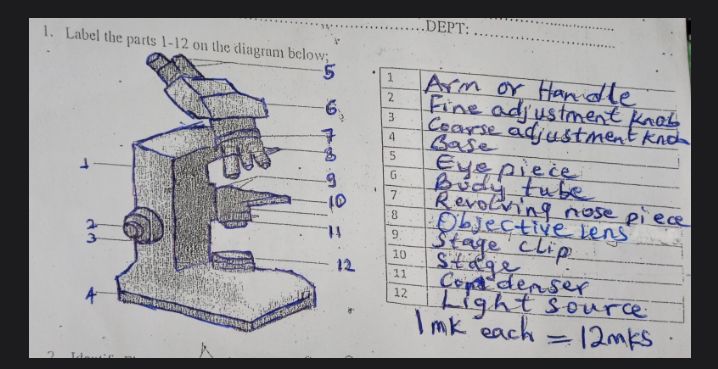
1. In a labeled diagram of a flower, which part is responsible for producing pollen?
A) Stigma
B) Style
C) Anther
D) Ovary
Answer: C) Anther
2. In the microscope diagram, what is the function of the objective lens?
A) To illuminate the specimen
B) To magnify the image
C) To focus the light
D) To hold the slide
Answer: B) To magnify the image
3. In the diagram of a typical leaf, which part is responsible for gas exchange?
A) Cuticle
B) Mesophyll
C) Stomata
D) Veins
Answer: C) Stomata
4. Identify the part labeled ‘A’ in a flower diagram that receives pollen.
A) Ovule
B) Stigma
C) Filament
D) Petal
Answer: B) Stigma
5. In the labeled drawing of a microscope, which part controls the amount of light that reaches the specimen?
A) Arm
B) Base
C) Diaphragm
D) Stage
Answer: C) Diaphragm
6. In a labeled diagram of algae, which structure is responsible for photosynthesis?
A) Stipe
B) Blade
C) Holdfast
D) Pneumatocyst
Answer: B) Blade
7. In the cryptogam diagram, which structure produces spores?
A) Gametophyte
B) Sporophyte
C) Rhizome
D) Frond
Answer: B) Sporophyte
8. In a labeled diagram of a flower, which part develops into the fruit?
A) Ovule
B) Ovary
C) Stigma
D) Petal
Answer: B) Ovary
9. Identify the structure in a plant cell that provides rigidity and support.
A) Cell membrane
B) Chloroplast
C) Cell wall
D) Nucleus
Answer: C) Cell wall
10. In the labeled diagram of a spermatophyte, which structure contains the seeds?
A) Stamen
B) Cone
C) Leaf
D) Root
Answer: B) Cone
11. In a flower diagram, which part is typically colorful and attracts pollinators?
A) Sepal
B) Petal
C) Anther
D) Ovary
Answer: B) Petal
12. In a diagram of a microscope, what is the purpose of the eyepiece?
A) To illuminate the specimen
B) To magnify the image for viewing
C) To hold the slide in place
D) To adjust focus
Answer: B) To magnify the image for viewing
13. In the diagram of a typical algae, what is the function of the holdfast?
A) To perform photosynthesis
B) To anchor the algae to a substrate
C) To store nutrients
D) To absorb water
Answer: B) To anchor the algae to a substrate
14. In a labeled drawing of a cryptogam, which part is typically involved in reproduction?
A) Stipe
B) Frond
C) Spores
D) Rhizome
Answer: C) Spores
15. In a spermatophyte diagram, which structure is responsible for the production of male gametes?
A) Ovule
B) Anther
C) Stigma
D) Style
Answer: B) Anther
16. In a labeled diagram of a flower, which part is typically green and protects the developing flower bud?
A) Petal
B) Sepal
C) Stamen
D) Ovary
Answer: B) Sepal
17. In a microscope diagram, which part is used to focus the image?
A) Stage clips
B) Coarse adjustment knob
C) Arm
D) Base
Answer: B) Coarse adjustment knob
18. Identify the photosynthetic structure in a labeled algae drawing.
A) Stipe
B) Blade
C) Holdfast
D) Frond
Answer: B) Blade
19. In the diagram of a flowering plant, which part is involved in the absorption of water and nutrients?
A) Stem
B) Leaves
C) Roots
D) Flowers
Answer: C) Roots
20. In a labeled flower diagram, which part is responsible for producing ovules?
A) Stigma
B) Anther
C) Ovary
D) Style
Answer: C) Ovary
21. In a diagram of a microscope, what is the function of the stage?
A) To hold the eyepiece
B) To support the slide
C) To control the light
D) To focus the lens
Answer: B) To support the slide
22. Identify the reproductive structure in a labeled algae diagram.
A) Blade
B) Stipe
C) Holdfast
D) Spore
Answer: D) Spore
23. In a labeled diagram of cryptogams, which part is responsible for photosynthesis?
A) Rhizome
B) Frond
C) Sporangium
D) Spores
Answer: B) Frond
24. In a spermatophyte diagram, what is the function of the ovule?
A) To produce pollen
B) To develop into the seed
C) To anchor the plant
D) To absorb nutrients
Answer: B) To develop into the seed
25. In a flower diagram, which structure supports the anther?
A) Filament
B) Stigma
C) Petal
D) Ovary
Answer: A) Filament
26. In a microscope diagram, which part is used for fine adjustments?
A) Coarse adjustment knob
B) Base
C) Fine adjustment knob
D) Arm
Answer: C) Fine adjustment knob
27. In a labeled algae drawing, which part is often buoyant and helps the algae float?
A) Blade
B) Stipe
C) Pneumatocyst
D) Holdfast
Answer: C) Pneumatocyst
28. In a labeled flower diagram, which part contains the pollen?
A) Ovule
B) Anther
C) Style
D) Stigma
Answer: B) Anther
29. Identify the part of the microscope that provides stability.
A) Base
B) Arm
C) Stage
D) Eyepiece
Answer: A) Base
30. In a cryptogam diagram, which part produces gametes?
A) Sporophyte
B) Gametophyte
C) Frond
D) Rhizome
Answer: B) Gametophyte
31. In a labeled diagram of a flower, which part develops into the seed after fertilization?
A) Ovule
B) Petal
C) Anther
D) Style
Answer: A) Ovule
32. In a microscope diagram, what is the purpose of the light source?
A) To magnify the specimen
B) To illuminate the specimen
C) To focus the lens
D) To hold the slide
Answer: B) To illuminate the specimen
33. Identify the structure labeled ‘C’ in a diagram of a flowering plant that stores nutrients.
A) Root
B) Leaf
C) Stem
D) Flower
Answer: A) Root
34. In a labeled algae drawing, what is the role of the stipe?
A) To anchor the algae
B) To absorb nutrients
C) To support the blades
D) To produce spores
Answer: C) To support the blades
35. In a labeled flower diagram, what does the term “pistil” refer to?
A) The male reproductive part
B) The female reproductive part
C) The outer layer of petals
D) The stem
Answer: B) The female reproductive part
36. In the diagram of a microscope, which part holds the objective lenses?
A) Arm
B) Revolving nosepiece
C) Stage
D) Base
Answer: B) Revolving nosepiece
37. In a labeled cryptogam drawing, which structure is primarily involved in asexual reproduction?
A) Frond
B) Spore
C) Rhizome
D) Gametophyte
Answer: B) Spore
38. In a labeled diagram of a flower, what part is typically not involved in reproduction?
A) Stamen
B) Petal
C) Sepal
D) Ovary
Answer: C) Sepal
39. In a diagram of a microscope, what is the function of the stage clips?
A) To hold the eyepiece
B) To secure the slide in place
C) To illuminate the specimen
D) To adjust the focus
Answer: B) To secure the slide in place
40. In a labeled algae diagram, what is the primary function of the holdfast?
A) To perform photosynthesis
B) To anchor the algae to a substrate
C) To absorb nutrients
D) To store energy
Answer: B) To anchor the algae to a substrate
41. In a flower diagram, which part is typically green and protects the developing flower?
A) Petal
B) Sepal
C) Anther
D) Style
Answer: B) Sepal
42. In a labeled diagram of a spermatophyte, what is the role of the pollen grain?
A) To produce seeds
B) To fertilize the ovule
C) To absorb water
D) To anchor the plant
Answer: B) To fertilize the ovule
43. In a labeled drawing of a microscope, what part is adjusted to change the focus of the specimen?
A) Coarse adjustment knob
B) Diaphragm
C) Stage
D) Arm
Answer: A) Coarse adjustment knob
44. Identify the part labeled ‘A’ in a cryptogam diagram that contains spores.
A) Frond
B) Sori
C) Rhizome
D) Stipe
Answer: B) Sori
45. In a labeled diagram of a flower, which part typically attracts pollinators with its color and scent?
A) Sepal
B) Stamen
C) Petal
D) Ovary
Answer: C) Petal
46. In a diagram of algae, what is the function of the blade?
A) To anchor the algae
B) To perform photosynthesis
C) To produce spores
D) To absorb nutrients
Answer: B) To perform photosynthesis
47. In a labeled drawing of a flower, which part is the male reproductive structure?
A) Ovule
B) Pistil
C) Stamen
D) Sepal
Answer: C) Stamen
48. In the diagram of a microscope, which part helps to adjust the light intensity?
A) Coarse adjustment knob
B) Diaphragm
C) Arm
D) Base
Answer: B) Diaphragm
49. Identify the reproductive structures in a labeled cryptogam diagram.
A) Fronds
B) Spores
C) Rhizomes
D) Holdfasts
Answer: B) Spores
50. In a labeled flower diagram, what is the function of the style?
A) To support the stigma
B) To produce pollen
C) To protect the ovary
D) To attract pollinators
Answer: A) To support the stigma

